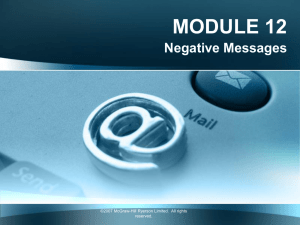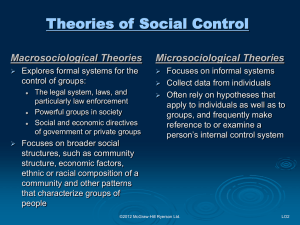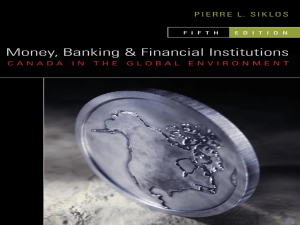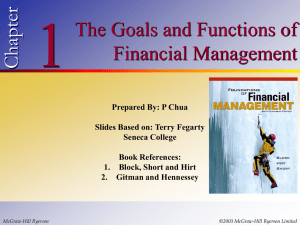Options
advertisement
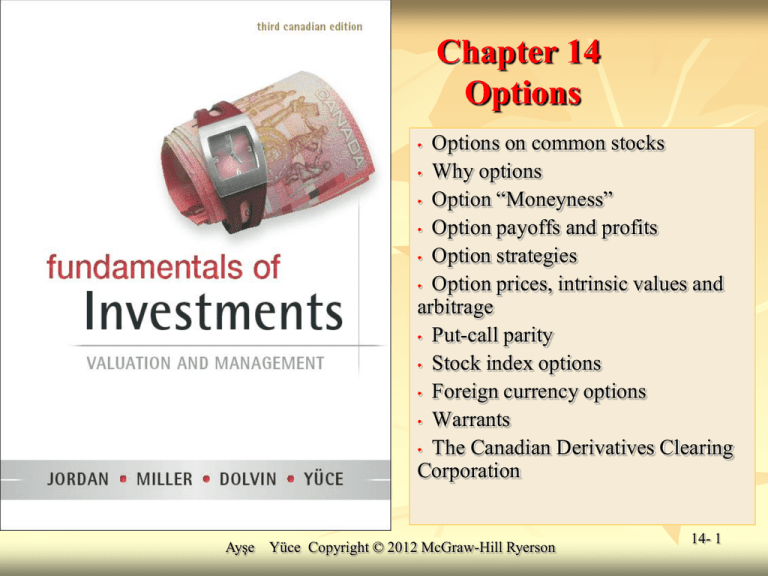
Chapter 14 Options Options on common stocks • Why options • Option “Moneyness” • Option payoffs and profits • Option strategies • Option prices, intrinsic values and arbitrage • Put-call parity • Stock index options • Foreign currency options • Warrants • The Canadian Derivatives Clearing Corporation • Ayşe Yüce Copyright © 2012 McGraw-Hill Ryerson 14- 1 Stock Options In this chapter, we will discuss general features of options, but will focus on options on individual common stocks. We will see the tremendous flexibility that options offer investors in designing investment strategies. © 2009 McGraw-Hill Ryerson Limited 14- 2 Option Basics A stock option is a derivative security, because the value of the option is “derived” from the value of the underlying common stock. There are two basic option types. Call options are options to buy the underlying asset. Put options are options to sell an underlying asset. Listed Option contracts are standardized to facilitate trading and price reporting. Listed stock options give the option holder the right to buy or sell 100 shares of stock. © 2009 McGraw-Hill Ryerson Limited 14- 3 Option Basics Option contracts are legal agreements between two parties— the buyer of the option, and the seller of the option. The minimum terms stipulated by stock option contracts are: The identity of the underlying stock. The strike price, or exercise price. The option contract size. The option expiration date, or option maturity. The option exercise style (American or European). The delivery, or settlement, procedure. Stock options trade at organized options exchanges, such as the CBOE, as well as over-the-counter (OTC) options markets. © 2009 McGraw-Hill Ryerson Limited 14- 4 Option Price Quotes A list of available option contracts and their prices for a particular security is known as an option chain. Option chains are available online through many sources, including the Montreal exchange (http://www.m-x.ca), CBOE (http://quote.cboe.com) and Yahoo! (http://finance.yahoo.com). Stock option ticker symbols include: Letters to identify the underlying stock. A Letter to identify the expiration month as well as whether the option is a call or a put. A Letter to identify the strike price (a bit more complicated—see Yahoo or Stock-Trak for tables to explain this letter.) © 2009 McGraw-Hill Ryerson Limited 14- 5 Listed Option Quotes on the Web 14- 6 The Canadian Derivatives Clearing Corporation The Canadian Derivatives Clearing Corporation is the clearing agency for all derivatives exchanges in Canada (Montreal and Winnipeg). All option contracts traded in Canada are originally issued, guaranteed, and cleared by the CDCC. Brokerage firms merely act as intermediaries between investors and the CDCC. Visit the CDCC at: www.cdcc.com. © 2009 McGraw-Hill Ryerson Limited 14- 7 Why Options? A basic question asked by investors is: “Why buy stock options instead of shares in the underlying stock?” To answer this question, we compare the possible outcomes from these two investment strategies: Buy the underlying stock Buy options on the underlying stock © 2009 McGraw-Hill Ryerson Limited 14- 8 Buying the Stock versus Buying a Call Option IBM is selling for $90 per share and call options with a strike price of $90 are $5 per share. Investment for 100 shares: IBM Shares: $9,000 One listed call option contract: ($500) Suppose further that the option expires in three months.Finally, let’s say that in three months, the price of IBM shares will either be: $100, $90, or $80. © 2009 McGraw-Hill Ryerson Limited 14- 9 Buying the Underlying Stock versus Buying a Call Option Let’s calculate the dollar and percentage return given each of the prices for IBM stock: Buy 100 IBM Shares ($9000 Investment): Buy One Call Option ($500 Investment): Dollar Profit: Percentage Return: Dollar Profit: Percentage Return: Case I: $100 $1,000 11.11% $500 100% Case II: $90 $0 0% -$500 -100% Case III: $80 -$1,000 -11.11% -$500 -100% 14- 10 Why Options? Conclusion Whether one strategy is preferred over another is a matter for each individual investor to decide. That is, in some instances investing in the underlying stock will be better. In other instances, investing in the option will be better. Each investor must weight the risk and return trade-off offered by the strategies. It is important to see that call options offer an alternative means of formulating investment strategies. For 100 shares, the dollar gain and loss potential with call options is lower. The positive and negative percentage return with call options is higher. 14- 11 Stock Index Options A stock index option is an option on a stock market index. Because the actual delivery of all stocks comprising a stock index is impractical, stock index options have a cash settlement procedure. That is, if the option expires in the money, the option writer simply pays the option holder the intrinsic value of the option. The cash settlement procedure is the same for calls and puts. © 2009 McGraw-Hill Ryerson Limited 14- 12 Index Option Trading 14- 13 Option intrinsic Values The intrinsic value of an option is the payoff that an option holder receives if the underlying stock price does not change from its current value. That is, if S is the current stock price, and K is the strike price of the option: Call option intrinsic value = MAX[0, S –K] In words: The call option intrinsic value is the maximum of zero or the stock price minus the strike price. Put option intrinsic value = MAX[0, K –S] In words: The put option intrinsic value is the maximum of zero or the strike price minus the stock price. Ayşe Yüce Copyright © 2012 McGraw-Hill Ryerson 14 Intrinsic Values and Arbitrage, Calls Call options with American-style exercise must sell for at least their intrinsic value. (Otherwise, there is arbitrage) Suppose: S = $60; C = $5; K = $50. Instant Arbitrage. How? Buy the call for $5. Immediately exercise the call, and buy the stock for $50.In the next instant, sell the stock at the market price of $60. You made a profit with zero cash outlay. © 2009 McGraw-Hill Ryerson Limited 14- 15 Intrinsic Values and Arbitrage, Puts Put options with American-style exercise must sell for at least their intrinsic value. (Otherwise, there is arbitrage) Suppose: S = $40; P = $5; K = $50. Instant Arbitrage. How? Buy the put for $5. Buy the stock for $40. Immediately exercise the put, and sell the stock for $50 You made a profit with zero cash outlay. © 2009 McGraw-Hill Ryerson Limited 14- 16 Option “Moneyness” “In-the-money” option: An option that would yield a positive payoff if exercised “Out-of-the-money” option: An option that would NOT yield a positive payoff if exercised Use the relationship between S (the stock price) and K (the strike price): In-theMoney Out-of-theMoney Call Option S>K S≤K Put Option S<K S≥K Note for a given strike price, only the call or the put can be “in-themoney.” © 2009 McGraw-Hill Ryerson Limited 14- 17 Option “Moneyness” “In the Money” options have a positive intrinsic value. “Out of the Money” options have a zero intrinsic value. For calls, the strike price is less than the stock price. For puts, the strike price is greater than the stock price. For calls, the strike price is greater than the stock price. For puts, the strike price is less than the stock price. “At the Money” options is a term used for options when the stock price and the strike price are about the same. Ayşe Yüce Copyright © 2012 McGraw-Hill Ryerson 18 Option Writing The act of selling an option is referred to as option writing. The seller of an option contract is called the writer. The Writer of a call option contract is obligated to sell the underlying asset to the call option holder. The call option holder has the right to exercise the call option (i.e., buy the underlying asset at the strike price). The Writer of a put option contract is obligated to buy the underlying asset from the put option holder. The put option holder has the right to exercise the put option (i.e., sell the underlying asset at the strike price). Because option writing obligates the option writer, the writer receives the price of the option today from the buyer. 14- 19 Option Exercise Option holders have the right to exercise their option. If this right is only available at the option expiration date, the option is said to have European-style exercise. If this right is available at any time up to and including the option expiration date, the option is said to have American-Style exercise. Exercise style is not linked to where the option trades. European-style and American-Style options trade in the U.S., as well as on other option exchanges throughout the world. Very Important: Option holders also have the right to sell their option at any time. That is, they do not have to exercise the option if they no longer want it. 14- 20 Option Payoffs versus Option Profits It is useful to think about option investment strategies in terms of their initial cash flows and terminal cash flows. The initial cash flow of an option is the price of the option which is often called the option premium. The terminal cash flow of an option is the value of an option at expiration. (The terminal cash flow can be realized by the option holder by exercising the option.) The terminal cash flow is often called the option payoff. Option Profits are calculated by subtracting the initial cash flow (option premium) from the terminal cash flow (option payoff). © 2009 McGraw-Hill Ryerson Limited 14- 21 Call Option Payoffs © 2009 McGraw-Hill Ryerson Limited 14- 22 Put Option Payoffs © 2009 McGraw-Hill Ryerson Limited 14- 23 Call Option Profits © 2009 McGraw-Hill Ryerson Limited 14- 24 Put Option Profits © 2009 McGraw-Hill Ryerson Limited 14- 25 Option Strategies Protective put - Strategy of buying a put option on a stock already owned. This protects against a decline in value (i.e., it is "insurance") Covered call - Strategy of selling a call option on stock already owned. This exchanges “upside” potential for current income. Straddle - Buying or selling a call and a put with the same exercise price. Buying is a long straddle; selling is a short straddle. There are many option trading strategies available to option traders. For ideas on option trading strategies, see: www.commodityworld.com www.writecall.com © 2009 McGraw-Hill Ryerson Limited 14- 26 Arbitrage Arbitrage: In finance, arbitrage is not allowed to persist. No possibility of a loss A potential for a gain No cash outlay “Absence of Arbitrage” = “No Free Lunch” The “Absence of Arbitrage” rule is often used in finance to figure out prices of derivative securities. Think about what would happen if arbitrage were allowed to persist. (Easy money for everybody) © 2009 McGraw-Hill Ryerson Limited 14- 27 The Upper Bound for a Call Option Price Call option price must be less than the stock price. Otherwise, arbitrage will be possible. Suppose you see a call option selling for $65, and the underlying stock is selling for $60. The arbitrage: sell the call, and buy the stock. Worst case? The option is exercised and you pocket $5. Best case? The stock sells for less than $65 at option expiration, and you keep all of the $65. There was zero cash outlay today, there was no possibility of loss, and there was a potential for gain. © 2009 McGraw-Hill Ryerson Limited 14- 28 The Upper Bound for a European Put Option Prices European Put option price must be less than the strike price. Otherwise, arbitrage will be possible. Suppose there is a put option with a strike price of $50 and this put is selling for $60. The Arbitrage: Sell the put, and invest the $60 in the bank. (Note you have zero cash outlay). Worse case? Stock price goes to zero. You must pay $50 for the stock (because you were the put writer). But, you have $60 from the sale of the put (plus interest). Best case? Stock price is at least $50 at expiration. The put expires with zero value (and you are off the hook). You keep the entire $60, plus interest. © 2009 McGraw-Hill Ryerson Limited 14- 29 The Upper Bound for European Put Option Prices There will be an arbitrage if price of the put, plus the interest you could earn over the life of the option, is greater than the stock price. For example, suppose the risk-free rate is 3 percent per quarter. We have a put option with an exercise price of $50 and 90 days to maturity. What is the maximum put value that does not result in an arbitrage? Maximum put price 1.03 $50 Maximum put price $50/1.03 $48.54 Notice that the answer, $48.54, is the present value of the strike price computed at the risk-free rate. Therefore: The maximum price for a European put option is the present value of the strike price computed at the risk-free rate. 30 The Lower Bound on Option Prices Option prices must be at least zero. An option holder can simply discard the option. This means that no one would pay someone to take an option off their hands. Therefore, the price of the option cannot be negative. American Calls. Can an American call sell for less than its intrinsic value? No. Suppose S = $60, and a call option has a strike price of K = $50 and a price of $5. The $5 call price is less than the intrinsic value of S - K = $10. The Arbitrage Strategy: Buy the call option at its price of C = $5. Immediately exercise the call option and buy the stock at K = $50. Then, sell the stock at the current market price of S = $60. Obtain $5 profit. Therefore, an American call option price is never less than its intrinsic value. Minimum American call option price = MAX[S - K, 0] 31 The Lower Bound on American Puts Can an American put sell for less than its intrinsic value? No. Suppose S = $40, and a put option has a strike price of K = $50 and a price of $5. The $5 put price is less than the intrinsic value of K - S = $10. The Arbitrage Strategy: Buy the put option at its price of P = $5. Buy the stock at its price of S = $40. Immediately exercise the put option and sell the stock at K = $50. Obtain $5 profit. Therefore, an American put option price is never less than its intrinsic value. Minimum American put option price = MAX[K - S, 0] Ayşe Yüce Copyright © 2012 McGraw-Hill Ryerson 32 The Lower Bounds for European Options European Calls. European options cannot be exercised before expiration. Therefore, we cannot use the arbitrage strategies to set lower bounds for American options. We must use a different approach (which can easily be found). The lower bound for a European call option is greater than its intrinsic value. European call option price ≥ MAX[S - K/(1 + r)T, 0] European Puts. The lower bound for a European put option price is less than its intrinsic value. In fact, in-the-money European puts will frequently sell for less than their intrinsic value. How much less? Using an arbitrage strategy that accounts for the fact that European put options cannot be exercised before expiration: European put option price ≥ MAX[K/(1 + r)T – S, 0] 33 Put-Call Parity Put-Call Parity is perhaps the most fundamental relationship in option pricing. Put-Call Parity is generally used for options with European-style exercise. Put-Call Parity states: the difference between the call price and the put price equals the difference between the stock price and the discounted strike price. © 2009 McGraw-Hill Ryerson Limited 14- 34 The Put-Call Parity Formula C P S K/(1 r) In the formula: T e-rT is a discount factor, so Ke-rT is simply the discounted strike price. C is the call option price today S is the stock price today r is the risk-free interest rate P is the put option price today K is the strike price of the put and the call T is the time remaining until option expiration Note: this formula can be rearranged: K/(1 r) S P C T 14- 35 Why Put-Call Parity Works If two securities have the same risk-less pay-off in the future, they must sell for the same price today. Today, suppose an investor forms the following portfolio: Buys 100 shares of Microsoft stock Writes one Microsoft call option contract Buys one Microsoft put option contract. At option expiration, this portfolio will be worth: $K 14- 36 Why Put-Call Parity Works At option expiration, this portfolio will be worth: © 2009 McGraw-Hill Ryerson Limited 14- 37 Put-Call Parity Notes Notice that the portfolio is always worth $K at expiration. That is, it is riskless. Therefore, the value of this portfolio today is $K/(1+r)T That is, to prevent arbitrage: today’s cost of buying 100 shares and buying one put (net of the proceeds of writing one call), should equal the price of a risk-less security with a face value of $K, and a maturity of T. Fun fact: If S = K (and if rT > 0), then C > P. © 2009 McGraw-Hill Ryerson Limited 14- 38 Useful Websites • • • For information on options ticker symbols, see: www.cboe.com www.m-x.ca To learn more about options, see: www.e-analytics.com www.tradingmarkets.com www.investorlinks.com Exchanges that trade index options include: www.cboe.com www.cbot.com www.cme.com www.m-x.ca © 2009 McGraw-Hill Ryerson Limited 14- 39

